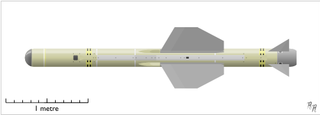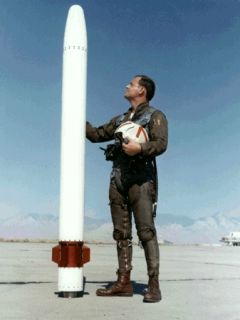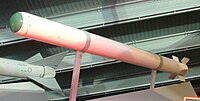The AIM-120 Advanced Medium-Range Air-to-Air Missile(AMRAAM) ( AM-ram) is an American beyond-visual-range air-to-air missile capable of all-weather day-and-night operations. It uses active transmit-receive radar guidance instead of semi-active receive-only radar guidance. When an AMRAAM missile is launched, NATO pilots use the brevity code "Fox Three".

The Advanced Short Range Air-to-Air Missile (ASRAAM), also known by its United States designation AIM-132, is an imaging infrared homing air-to-air missile, produced by MBDA UK, that is designed for close-range combat. It is in service in the Royal Air Force (RAF), replacing the AIM-9 Sidewinder. ASRAAM is designed to allow the pilot to fire and then turn away before the opposing aircraft can close for a shot. It flies at well over Mach 3 to ranges in excess of 25 kilometres (16 mi). It retains a 50 g maneuverability provided by body lift technology coupled with tail control.

Hawker Siddeley was a group of British manufacturing companies engaged in aircraft production. Hawker Siddeley combined the legacies of several British aircraft manufacturers, emerging through a series of mergers and acquisitions as one of only two such major British companies in the 1960s. In 1977, Hawker Siddeley became a founding component of the nationalised British Aerospace (BAe). Hawker Siddeley also operated in other industrial markets, such as locomotive building and diesel engine manufacture. The company was once a constituent of the FTSE 100 Index.

The IRIS-T is a medium range infrared homing air-to-air missile available in both air-to-air and ground defence surface-to-air variants. It also is called AIM-2000.

An air-to-air missile (AAM) is a missile fired from an aircraft for the purpose of destroying another aircraft. AAMs are typically powered by one or more rocket motors, usually solid fueled but sometimes liquid fueled. Ramjet engines, as used on the Meteor, are emerging as propulsion that will enable future medium- to long-range missiles to maintain higher average speed across their engagement envelope.

The RIM-7 Sea Sparrow is a U.S. ship-borne short-range anti-aircraft and anti-missile weapon system, primarily intended for defense against anti-ship missiles. The system was developed in the early 1960s from the AIM-7 Sparrow air-to-air missile as a lightweight "point-defense" weapon that could be retrofitted to existing ships as quickly as possible, often in place of existing gun-based anti-aircraft weapons. In this incarnation, it was a very simple system guided by a manually aimed radar illuminator.

The Skyflash, or Sky Flash in marketing material, was a medium-range semi-active radar homing air-to-air missile derived from the US AIM-7 Sparrow missile and carried by Royal Air Force McDonnell Douglas F-4 Phantoms and Tornado F3s, Italian Aeronautica Militare and Royal Saudi Air Force Tornados and Swedish Flygvapnet Saab Viggens.

Fireflash was the United Kingdom's first air-to-air guided missile to see service with the Royal Air Force. Constructed by Fairey Aviation, the missile utilised radar beam riding guidance. Fireflash had relatively limited performance and required the launching aircraft to approach the target from a limited angle astern.

The de Havilland Firestreak is a British first-generation, passive infrared homing air-to-air missile. It was developed by de Havilland Propellers in the early 1950s, entering service in 1957. It was the first such weapon to enter active service with the Royal Air Force (RAF) and Fleet Air Arm, equipping the English Electric Lightning, de Havilland Sea Vixen and Gloster Javelin. It was a rear-aspect, fire and forget pursuit weapon, with a field of attack of 20 degrees either side of the target.

The Hawker Siddeley Red Top was the third indigenous British air-to-air missile to enter service, following the de Havilland Firestreak and limited-service Fireflash. It was used to replace the Firestreak on the de Havilland Sea Vixen and later models of the English Electric Lightning.
A beyond-visual-range missile is an air-to-air missile that is capable of engaging at ranges of 20 nmi (37 km) or beyond. This range has been achieved using dual pulse rocket motors or booster rocket motor and ramjet sustainer motor.

Infrared homing is a passive weapon guidance system which uses the infrared (IR) light emission from a target to track and follow it seamlessly. Missiles which use infrared seeking are often referred to as "heat-seekers" since infrared is radiated strongly by hot bodies. Many objects such as people, vehicle engines and aircraft generate and emit heat and so are especially visible in the infrared wavelengths of light compared to objects in the background.

The AIM-95 Agile was an air-to-air missile developed by the United States. It was developed by the US Navy to equip the F-14 Tomcat, replacing the AIM-9 Sidewinder. Around the same time, the US Air Force was designing the AIM-82 to equip their F-15 Eagle, and later dropped their efforts to join the Agile program. In the end, newer versions of Sidewinder would close the performance gap so much that the Agile program was canceled.

The Mitsubishi AAM-3 or Type 90 air-to-air missile
The Air Combat Evaluation (ACEVAL) and the Air Intercept Missile Evaluation (AIMVAL) were two back-to-back Joint Test & Evaluations chartered by the United States Department of Defense that ran from 1974-78 at Nellis Air Force Base in Nevada. Both the U.S. Air Force and U.S. Navy participated, contributing a team of F-15 Eagle and F-14 Tomcat fighter aircraft and using the local F-5E Aggressor aircraft as the Red Force. The fundamental question that needed to be answered was one of "quantity vs quality". Mock engagements showed that cheaper, lower-technology fighters armed with all-aspect missiles were able to destroy the more advanced, expensive F-15's and F-14's. These results of the AIMVAL/ACEVAL testing led to the Air Force decision to structure its fighter forces with a balance of cheaper F-16's along with the more expensive F-15's, and the Navy took a similar strategy in procuring cheaper F/A-18's along with the more expensive F-14's. The results had other impacts as well, such as decisions regarding missile development.
The V3E A-Darter is a modern short-range infrared homing air-to-air missile, featuring countermeasures resistance with a 180-degree look angle and 120-degrees per second track rate, developed by South Africa's Denel Dynamics and Brazil's Mectron, Avibras and Opto Eletrônica. It will equip the South African Air Force's Saab JAS 39 Gripen C/D and BAE Hawk 120, and the Brazilian Air Force's A-1M AMX, Northrop F-5BR and Gripen E/F. It was expected to be in production before the end of 2015. As of November 2022, no combat capable missiles had been produced.

The AIM-9 Sidewinder is a short-range air-to-air missile. Entering service with the United States Navy in 1956 and the Air Force in 1964, the AIM-9 is one of the oldest, cheapest, and most successful air-to-air missiles. Its latest variants remain standard equipment in most Western-aligned air forces. The Soviet K-13, a reverse-engineered copy of the AIM-9B, was also widely adopted.

The British Aerospace (BAe) P.1216 was a planned Advanced Short Take Off/Vertical Landing (ASTOVL) supersonic aircraft from the 1980s. It was designed by the former Hawker design team at Kingston upon Thames, Surrey, England that created the Harrier family of aircraft.

The British Aerospace Hawk 200 is a single-seat, single engine light multirole fighter designed for air defence, air denial, anti-shipping, interdiction, close air support, and ground attack.
















